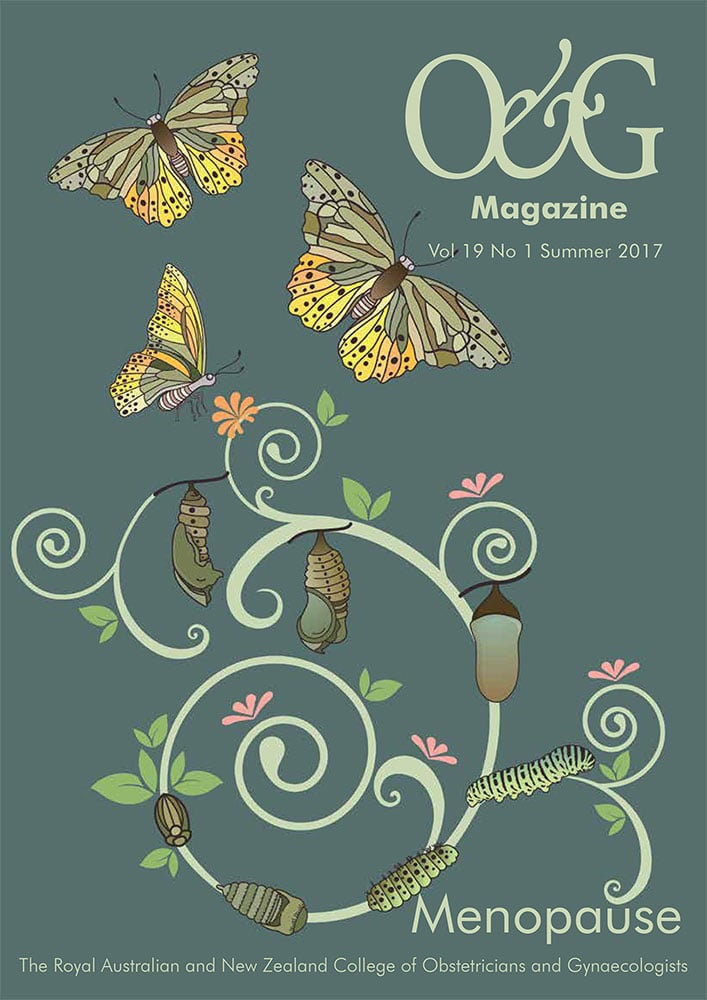Menopause symptoms are severe in 20 per cent of women, affecting their ability to function normally. The major symptoms of menopause are hot flushes and sweats, which are often worse at night, causing frequent waking. This leads to poor and interrupted sleep, which in turn causes tiredness and irritability. Other symptoms include aches and pains, which are the genitourinary symptoms relating to oestrogen loss.
Menopausal hormone therapy (MHT) is the ‘gold standard’ for treating severe menopause symptoms. It is recommended to commence MHT within 10 years of the final menstrual period, or between 50–60 years of age, as the risks associated with MHT are low during these time periods. However, women who have an early or premature menopause are recommended to take MHT until the expected age of menopause, not just for symptom relief, but to also reduce the risk of early onset of osteoporosis and cardiovascular disease.
Many women, however, have other comorbidities that affect their health and may complicate the management of their menopause symptoms. Some comorbidities exclude the use of MHT, while others may modify the type of hormone therapy prescribed.
There are few absolute contraindications for the use of MHT for the treatment of menopause symptoms. If symptoms are distressing and adversely affecting a woman’s quality of life (QoL), benefits of therapy must be weighed up against potential side effects.
Special considerations
- Suspected, active or history of breast cancer
- Venous thromboembolism (VTE) or thrombophilia (not taking anticoagulants), past venous thrombo-embolic event
- Undiagnosed/abnormal vaginal bleeding
- Active liver disease/gallstones
- Uncontrolled hypertension
- Cardiovascular disease (hypercholesterolaemia, hypertension, diabetes, ischemic heart disease) or the risk of it
- Suspected, active or history of endometrial cancer and ovarian cancer
- Endometriosis
- Migraine
- Obesity
- Porphyria cutanea tarda (PCT)
Non-hormonal medications
There is a range of prescriptive non-hormonal medications that can be offered in circumstances where MHT is not recommended. The efficacy and potential side effects of each option needs to be weighed up carefully. If these medications are to be effective in reducing hot flushes and sweats, it will be evident within the first four weeks of their use.
Regular follow up in the first six months to monitor symptoms and mitigate risk, dependent on the patient’s symptoms and medical conditions, is required.
Some of the most common prescription medications for management of menopausal symptoms are outlined below:
- Antidepressants: selective serotonin or serotonin-norepinephrine reuptake inhibitors (SSRIs/SNRIs) such as escitalopram, paroxetine, sertraline, venlafaxine and desvenlafaxine have been studied and found to relieve hot flushes by 50–60 per cent. Some common side effects reported are nausea, xerostomia, sexual dysfunction and insomnia. Sweating may also be a side effect.
- Clonidine: centrally acting, alpha-2 agonist, hypotensive agent and mild sedative. It has shown to be effective in reducing vasomotor symptoms by up to 50 per cent. Some common side effects may include dizziness, xerostomia, postural hypotension and somnolence.
- Gabapentin: an anticonvulsant that is used to treat epilepsy and chronic nerve pain, and has been shown to diminish hot flushes by up to 60 per cent. Its side effects may include somnolence, ataxia, dizziness and drowsiness.
Non-prescriptive therapies
Lifestyle modifications – including dressing in layers, using fans, cold packs, facial water sprays and identifying and avoiding triggers such as caffeine, alcohol, hot liquids and spicy foods – may be helpful. Weight loss may also reduce vasomotor symptoms. Exercise has not been shown to reduce vasomotor symptoms.
Cognitive behavioural therapy, mindfulness therapy and hypnotherapy have been shown to reduce vasomotor symptoms, while acupuncture studies suggest insufficient evidence of efficacy.
Studies of across-the-counter therapies, including herbal remedies such as black cohosh, red clover and St John’s Wort, are inconsistent. Some phytoestrogens have been shown to be effective in reducing vasomotor symptoms. Safety data, however, for phytoestrogen supplements in breast cancer patients have not been established. Black cohosh is not a phytoestrogen and may work in a similar manner to the neurotransmitters.
Vaginal lubricants and moisturisers
Lubricants recommended are water-based, as they have fewer side effects than silicone-based brands. There are many additives in lubricants, including preservatives and parabens, that affect osmolality and pH.
The effectiveness of the lubricant therefore depends on the osmolality and pH of each product. High osmolality of more than1200mOsm/kg is associated with irritation, contact dermatitis and cytotoxicity.
Moisturisers are used to rehydrate the dry vaginal tissues by changing the fluid content in the epithelium, absorbing and adhering to it, mimicking vaginal secretions and lowering the pH. They are effective for 2–3 days. Moisturisers also contain polymers for adherence and other additives that affect osmolality and pH.
Conditions to consider
In women with special considerations, a multidisciplinary team approach will help to optimise management and treatment. Liaising with each of the patient’s treating health professionals allows the individual woman the opportunity to weigh up the risks and benefits of the recommended treatments.
Breast cancer survivors
Breast cancer survivors, especially when menopause is a result of the breast cancer treatments, will frequently have more severe vasomotor and genitourinary symptoms than women without breast cancer. Up to 95 per cent of women with a history of breast cancer will complain of vasomotor symptoms and 50–75 per cent will complain of at least one genitourinary symptom. For vasomotor symptoms, non-hormonal preparations are recommended. First-line therapy is usually either a SSRI/SNRI or gabapentin.
Escitalopram is considered the most effective SSRI, with fewer side effects. The recommended dosage is 10–20mg. Venlafaxine has been used for many years and the effective dose is 75–150mg. Gabapentin is particularly effective in women who have a major sleep disturbance due to the vasomotor symptoms regularly interrupting sleep, as it causes drowsiness and somnolence as well as reducing the menopause symptoms. The recommended dose is 900mg at night. If clonidine is prescribed, the dose recommended is 100–150μg nightly. Women should be advised to have their blood pressure checked because of the possible side effect of hypotension. All of these medications should be started slowly with the lowest dose, building up to the recommended dose depending on the side effects and symptom response. Fluoxetine and paroxetine are cytochrome P450 2D6 inhibitors and should not be used in women who are taking tamoxifen, as they can inhibit the tamoxifen effect and increase the possible risk of further disease.
For genitourinary symptoms, treatment will depend on which symptoms are bothersome. Lubricants and moisturisers are recommended initially in woman experiencing vaginal dryness and some discomfort during intercourse. If symptoms are more bothersome and severely affecting QoL, then vaginal oestrogen preparations may be considered. The use of vaginal oestrogen in breast cancer survivors is controversial, especially in those women on aromatase inhibitors (AIs), as long-term safety has not been confirmed. Further research is needed.
Oestradiol preparations are not recommended because of the safety concern that oestradiol levels will be elevated systemically and therefore increase risk of recurrence. The low-dose oestradiol 10μg vaginal tablet, however, has a very low absorption over a 12-month period of 1.14mg oestradiol. Oestriol preparations do not elevate the oestradiol level as they are not transformed into oestradiol or oestrone.
Oestriol vaginal creams or pessaries are considered to be the more appropriate therapy to use. Some studies have suggested using these preparations intermittently for short periods of time.
VTE or thrombophilia
Non-hormonal therapies are recommended in high-risk women and those with a thrombophilia. Before prescribing hormone therapy, careful assessment of personal and family history of VTE is essential. Oral oestrogen therapy is contraindicated in women with a history of VTE. Transdermal MHT has a very low thrombotic risk, whereas tibolone shows no prothrombotic risk. These therapies may be suitable in low-risk or normal women, or those on anticoagulants. Some oral progestogens, such as medroxyprogesterone acetate, norethisterone derivatives and continuous combined regimens are associated with greater risk of VTE compared to dydrogesterone and progesterone. Discussion with the woman’s haematologist is appropriate before prescribing any therapy.
Abnormal vaginal bleeding
Undiagnosed vaginal bleeding is a contraindication for MHT. The cause of the bleeding needs to be determined and treated before MHT for menopause symptoms is considered.
Active liver disease/gallstones
Oral MHT increases the risk of cholecystitis, but transdermal therapies do not have the same effect and therefore are appropriate in symptomatic women.
Uncontrolled hypertension
Hypertension should be treated with antihypertensive medications. Once the blood pressure is controlled, MHT may
be appropriate.
Cardiovascular disease or at risk
Symptomatic women with cardiovascular disease should be assessed carefully. Consultation with the woman’s cardiologist or physician prior to prescribing MHT is necessary. Avoid MHT if multiple risks are present; transdermal therapies may be appropriate if symptoms are affecting the woman’s QoL.
Endometrial and ovarian cancer
Early-stage endometrial cancer is not a contraindication to oestrogen replacement therapy. Studies are limited in the use of MHT in in higher stages of the disease. Ovarian cancer is not a contraindication to MHT except germ cell tumours. Oestrogen or tibolone are suitable.
Endometriosis
Surgical menopause is a consequence of hysterectomy and bilateral salpingo-oophorectomy for severe, recurrent endometriosis with chronic pelvic pain. There is controversy regarding the most appropriate therapy. Some experts recommend low-dose oestrogen therapy, whereas others recommend combined continuous MHT. Tibolone may also be suitable.
Migraine
Migraine without aura is not a contraindication to MHT, but non-oral transdermal continuous therapy is recommended. Some studies suggest high-dose oestrogens will provide more migraine control. The safety of hormone therapy in migraine with aura has not been established.
Obesity
Transdermal therapies are more appropriate than oral preparations because of the increased thrombotic risk with obesity.
PCT
All forms of MHT are contraindicated in PCT. Non-hormonal therapies are suitable for menopause treatment.
Further reading
International Menopause Society (UK). 2015. www.imsociety.org
Baber R, Panay N, Fenton A. 2016 IMS Recommendations on women’s midlife health and menopause hormone therapy, Climacteric. 2016;19(2)109-150. DOI: 10.3109/13697137.2015.1129166.
de Villiers TJ, Hall JE, Pinkerton JV, et al. Revised Global Consensus Statement on Menopausal Hormone Therapy, Climacteric. DOI: 10.1080/13697137.2016.1196047.
Vincent AJ. Management of menopause in women with breast cancer, Climacteric. 2015;18(5)690-701. DOI:10.3109/13697137.2014.996749.
Collaborative Group on Epidemiological Studies of Ovarian Cancer. Menopausal hormone use and ovarian cancer risk: individual participant meta-analysis of 52 epidemiological studies. Lancet. 2015;385(9980)1835-1842.





Leave a Reply